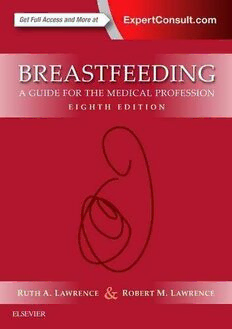
Breastfeeding: A Guide for the Medical Profession PDF
Preview Breastfeeding: A Guide for the Medical Profession
Breastfeeding A GUIDE FOR THE MEDICAL PROFESSION MadonnaandChild,SchoolofBruges,Flemish,15thcenturycoloreddrawing.(Reproducedwith permission from MemorialArt Gallery of the Universityof Rochester.) Breastfeeding A GUIDE FOR THE MEDICAL PROFESSION Eighth Edition Ruth A. Lawrence, MD Northumberland Trust Chair inPediatrics DistinguishedAlumnaProfessor of Pediatrics, Obstetrics,and Gynecology Departmentof Pediatrics University of Rochester School ofMedicine and Dentistry Rochester, New York Robert M. Lawrence, MD Clinical Professor of Pediatrics PediatricImmunology, Rheumatology, and InfectiousDiseases Departmentof Pediatrics University ofFlorida Collegeof Medicine Gainesville, Florida 1600JohnF.KennedyBlvd. Ste1800 Philadelphia,PA19103-2899 BREASTFEEDING:AGUIDEFORTHEMEDICALPROFESSION,EIGHTHEDITION ISBN:978-0-323-35776-0 Copyright©2016byElsevier,Inc.Allrightsreserved. No part of this publication may be reproduced or transmitted in any form or by any means, electronic or mechanical, including photocopying, recording, or any information storage and retrieval system, without permission in writing from the Publisher. Details on how to seek permission, further information about the Publisher’s permissions policies and our arrangements with organizations such as the Copyright Clearance CenterandtheCopyrightLicensingAgency,canbefoundatourwebsite:www.elsevier.com/permissions. ThisbookandtheindividualcontributionscontainedinitareprotectedundercopyrightbythePublisher(other thanasmaybenotedherein). Notices Knowledgeandbestpracticeinthisfieldareconstantlychanging.Asnewresearchandexperiencebroaden ourunderstanding,changesinresearchmethods,professionalpractices,ormedicaltreatmentmaybecome necessary. Practitionersandresearchersmustalwaysrelyontheirownexperienceandknowledgeinevaluatingand usinganyinformation,methods,compounds,orexperimentsdescribedherein.Inusingsuchinformationor methodstheyshouldbemindfuloftheirownsafetyandthesafetyofothers,includingpartiesforwhomthey haveaprofessionalresponsibility. Withrespecttoanydrugorpharmaceuticalproductsidentified,readersareadvisedtocheckthemost currentinformationprovided(i)onproceduresfeaturedor(ii)bythemanufacturerofeachproducttobe administered,toverifytherecommendeddoseorformula,themethodanddurationofadministration,and contraindications.Itistheresponsibilityofpractitioners,relyingontheirownexperienceandknowledgeof theirpatients,tomakediagnoses,todeterminedosagesandthebesttreatmentforeachindividualpatient,and totakeallappropriatesafetyprecautions. Tothefullestextentofthelaw,neitherthePublishernortheauthors,contributors,oreditors,assumeany liabilityforanyinjuryand/ordamagetopersonsorpropertyasamatterofproductsliability,negligenceor otherwise,orfromanyuseoroperationofanymethods,products,instructions,orideascontainedinthe materialherein. Previouseditionscopyrighted2011,2005,1999,1994,1989,1985,1980byMosby,anaffiliateofElsevierInc. LibraryofCongressCataloging-in-PublicationData Lawrence,RuthA.,date,author. Breastfeeding:aguideforthemedicalprofession/RuthA.Lawrence,RobertM.Lawrence.–Edition:8. p.;cm. Includesbibliographicalreferencesandindex. ISBN978-0-323-35776-0(pbk.:alk.paper) I.Lawrence,RobertM.(RobertMichael),date,author.II.Title. [DNLM:1.BreastFeeding.2.Lactation.3.Milk,Human.WS125] RJ216 6490.33–dc23 2015032368 ExecutiveContentStrategist:KateDimock ContentDevelopmentSpecialist:MargaretNelson PublishingServicesManager:PatriciaTannian SeniorProjectManager:SharonCorell BookDesigner:RyanCook PrintedinUnitedStatesofAmerica. Lastdigitistheprintnumber:9 8 7 6 5 4 3 2 1 In loving memory of John Charles Lawrence March 5, 1966, to October 9, 2008 and Robert Marshall Lawrence, MD June 28, 1923, to August 13, 2005 — Ruth A. Lawrence Sincerely dedicated to all of the health professionals who continue to support women in their efforts to breastfeed their children — Robert M. Lawrence This page intentionally left blank Foreword The 5 years since the publication of the seventh newbornisleftquietlyonthemother’sabdomenafter edition of this excellent book have been a time of birthheorshewill,afterabout30minutes,gradually incredible advances inunderstanding several previ- crawl up to the mother’s breast, find the nipple, ouslyunknownphysiologicandbehavioralprocesses self-attach,andstarttosuckleonhisorherown. directly linked to or associated with breastfeeding Itwouldappearthateachofthesefeatures—the andbeautifullydescribedinthisnewvolume. crawlingabilityoftheinfant,theabsenceofcrying These findings change our view of the mother- whenskin-to-skinwiththemother,andthewarm- infant relationship and signal an urgent need to ing capabilities of the mother’s chest—evolved completelyreviewpresentperinatalcareprocedures. genetically more than 400,000 years ago to help These new researchresults include the observation preserve the infant’s life. that, when an infant suckles from the breast, there Research findings related to the 1991 Baby isalargeoutpouringof19differentgastrointestinal Friendly Hospital Initiative (BFHI) of WHO and hormones, including cholecystokinin, gastrin, and UNICEF provided insight into an additional basic insulin,inbothmotherandinfant.Severalofthese process.AftertheintroductionoftheBFHI,which hormones stimulate the growth of the baby’s and emphasized mother-infant contact with an oppor- themother’sintestinalvilli,thusincreasingthesur- tunityforsucklinginthefirst30minutesafterbirth face area for the absorption of additional calories and mother-infant rooming-in throughout the with each feeding. The stimulus for these changes hospital stay, there has been a significant drop in is touching the nipple of the mother or the inside neonatal abandonment reported in maternity hos- of the infant’s mouth. The stimulus in both infant pitals in Thailand, Costa Rica, the Philippines, andmotherresultsinthereleaseofoxytocininthe and St. Petersburg, Russia. periventricularareaofthebrain,whichleadstopro- A key to understanding this behavior is the duction of these hormones via the vagus nerve. observation that, if the lips of an infant touch Thesepathwayswereessentialforsurvivalthousands the mother’s nipple in the first half hour of life, ofyearsago,whenperiodsoffaminewerecommon, the mother will decide to keep the infant in her before the development of modern agriculture and room 100 minutes longer on the second and third thestorageofgrain. daysofhospitalizationthanamotherwhoseinfant Thediscoveryoftheadditionalsignificanceofa doesnottouchhernippleinthefirst30minutes.It mother’s breast and chest tothe infantcomes from appearsthattheseremarkablechangesinmaternal thestudiesofSwedishresearcherswhohaveshown behavior are probably related to increased brain that a normal infant, placed on the mother’s chest, oxytocin levels shortly after birth. Thesechanges, andcoveredwithalightblanket,willwarmormain- in conjunction with known sensory, physiologic, tain body temperature as well as an infant warmed immunologic, and behavioral mechanisms, attract withelaborate,high-techheatingdevices.Thesame themotherandinfanttoeachotherandstarttheir researchersfoundthat,wheninfantsareskin-to-skin attachment. As pointed out back in the fifth edi- withtheirmothersforthefirst90minutesafterbirth, tion, a strong, affectionate bond is most likely to theyhardlycryatallcomparedwithinfantswhoare develop successfully with breastfeeding, in which dried,wrappedinatowel,andplacedinabassinet.In close contact and interaction occur repeatedly addition, the researchers demonstrated that if a when an infant wishes and at a pace that fits the vii viii Foreword needs and wishes of the mother and the infant, SUGGESTEDREADING resultingingratificationforboth.Thusbreastfeed- 1. ChristenssonK,CabreraT,ChristenssonE,etal:Separation ing plays a central role in the development of a distresscallinthehumanneonateintheabsenceofmaternal strongmother-infantattachmentwhenbegunwith bodycontact.InChristenssonK, editor:Careof thenewborn contact immediately after birth, which in turn has infant:satisfyingtheneedforcomfortandenergyconservation[thesis], been shown to be a simple maneuver to signifi- Stockholm,1994,KarolinskaInstitute. 2. ChristenssonK,SilesC,MorenoL,etal:Temperature,met- cantly increase the success of breastfeeding. All abolicadaptationandcryinginhealthynewborncaredfor oftheseexcitingfindingsprovidefurtherevidence skin-to-skinorinacot,ActaPaediatrScand81:488,1992. ofwhybreastfeedinghasbeensocrucialinthepast 3. Uvna¨s-MobergK:Thegastrointestinaltractingrowthand and deserves even strong supportnow. reproduction,SciAm261:78,1988.2568686. 4. Widstro€mAM,Ransjo-ArvidsonAB,ChristenssonK,etal: Inaddition,thepastfewyearshavebeenasso- Gastricsuctioninhealthynewborninfants:effectsoncircu- ciated with fundamental biochemical findings, lation and developing feeding behavior, Acta Paediatr Scand includingtheimportanceofdocosahexaenoicacid 76:566,1987.3630673. (DHA) in optimal brain development. All in all, 5. Widstro€mAM,WahlbergV,MatthiesenAS,etal:Short-term the many new observations described in this effectsofearlysucklingandtouchofthenippleonmaternal behavior,EarlyHumDev21:153,1990.2311552. eighth edition place milk and the process of 6. KlausM,KlausP:AcademyofBreastfeedingMedicineFoun- breastfeedinginakeypositioninthedevelopment der’sLecture2009:maternitycarere-evaluated,BreastfeedMed of many critical functions in human infants and 5(3):3,2010.20121428. theirmothers.Wesalutetheauthorforherspecial skill in bringing together these many unique and original observations in this new and most valu- John H.Kennell (1922–2013) able book. Marshall J.Klaus
